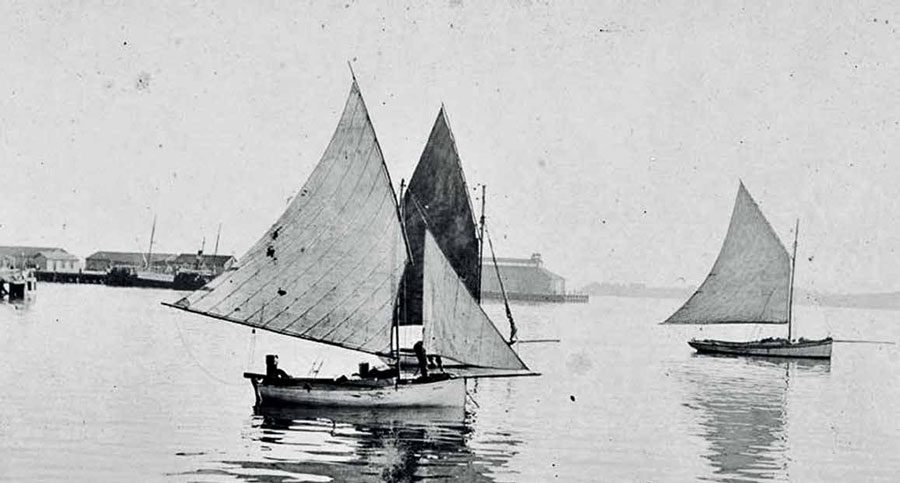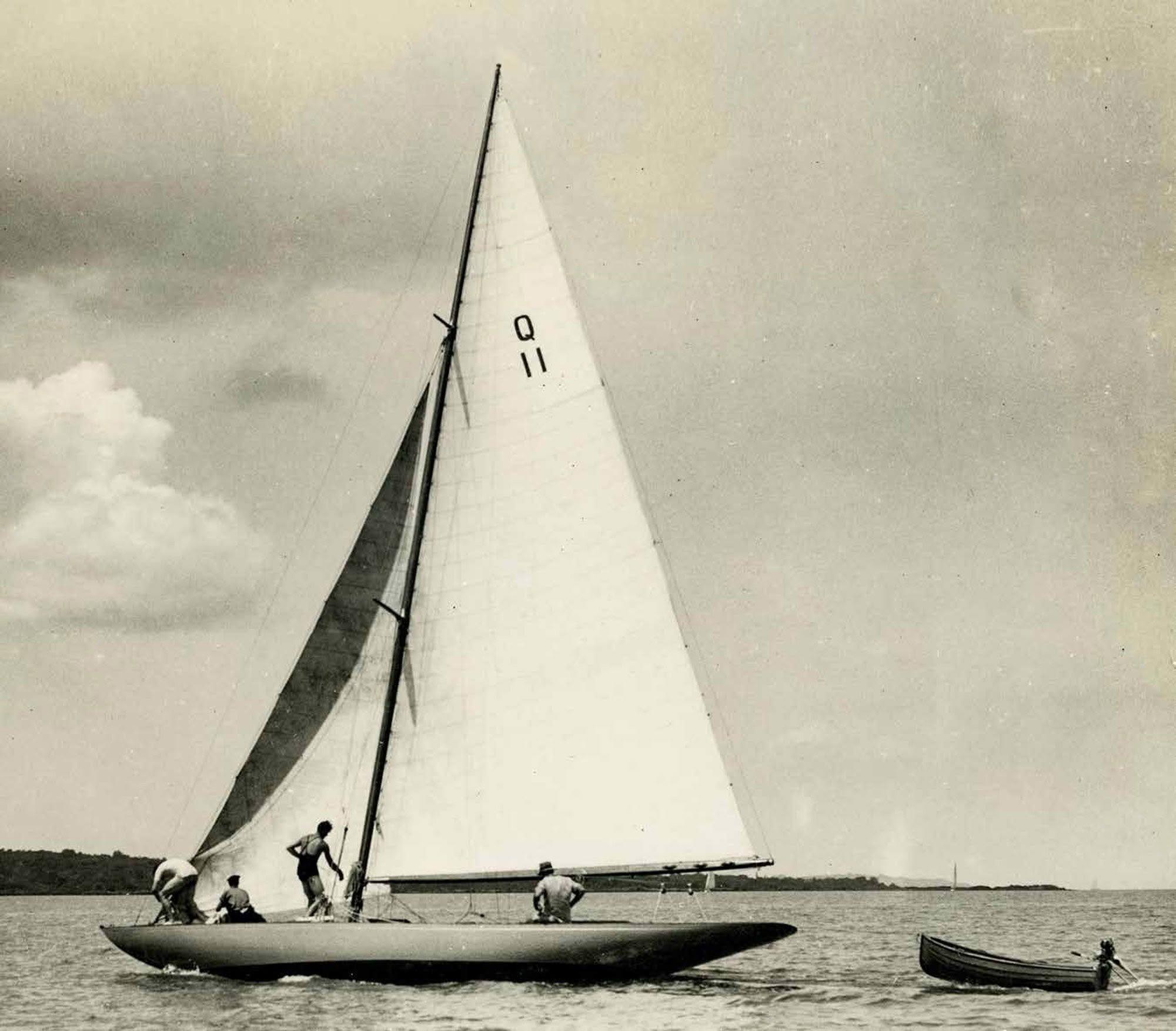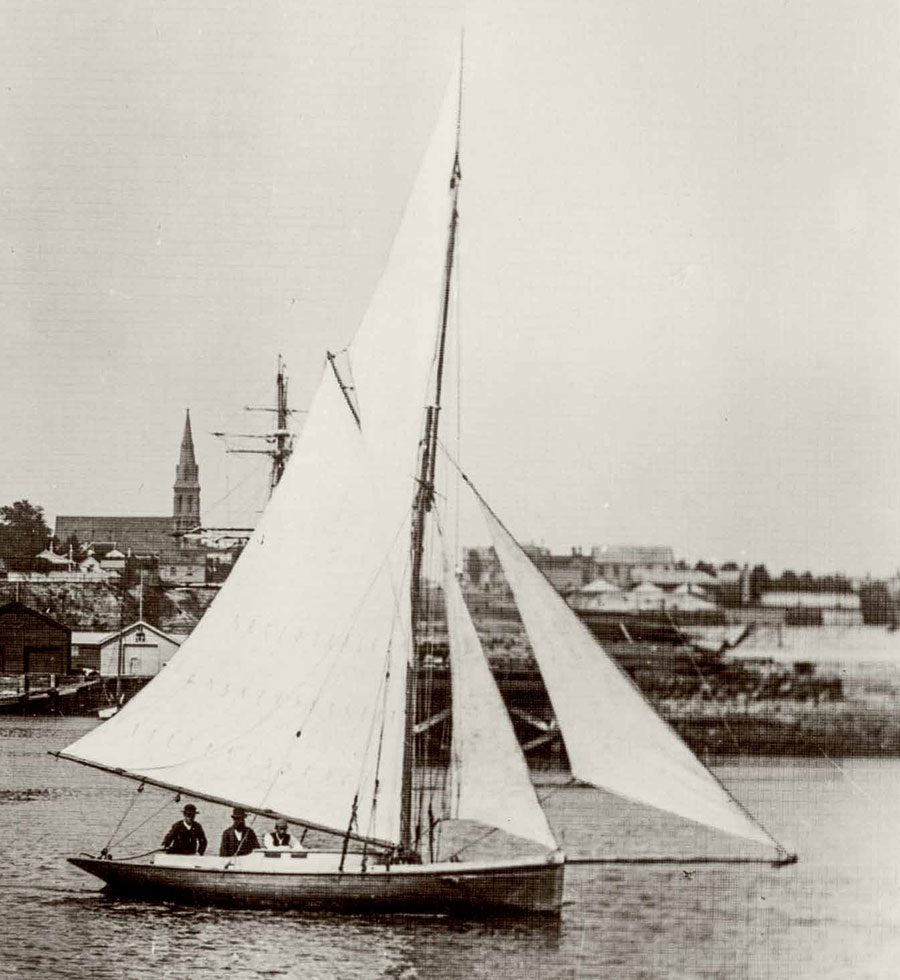

Two brothers, Frank (Francis Joseph) and Fred (Frederick William) Sanderson, played a big part in yachting in St. George’s Bay and Judges’ Bay during the mushroom growth of pleasure yachting on the Waitematā from the mid-1870s.
Both were born in the Midlands, Fred in 1860 in Manchester and Frank in 1862 in Staffordshire. Their parents migrated to Auckland in 1878 with Frank. They lived halfway down St. George’s Bay Road, Parnell. Fred stayed behind in England to complete his qualifications in accountancy at Cambridge University.
Frank started working in September 1878 as an invoice clerk at L.D. Nathan, a company that had many yachtsmen on the staff. He was a very tall man. When his older brother Fred arrived in 1880, he attended teacher training classes at Wellesley Street School and by June 1882 was first assistant to a Mr Smallfield at Mount Eden School.
Living where they did, the boys were inevitably involved in yachting and rowing. Sandy St. George’s Bay was at the foot of their street, where The Strand now runs, while Judge’s Bay was just around Campbell’s Point, the headland to the east. The first boat they owned, probably in late 1880, was the ‘open sailing boat’ Wave, a 13-footer which had recently been built by James Clare, probably commissioned by the Sandersons. The Observer said, sniffily, ”she does not belong to the genus ‘racer’, she is merely a good little sea-boat with some pretensions to shape.”

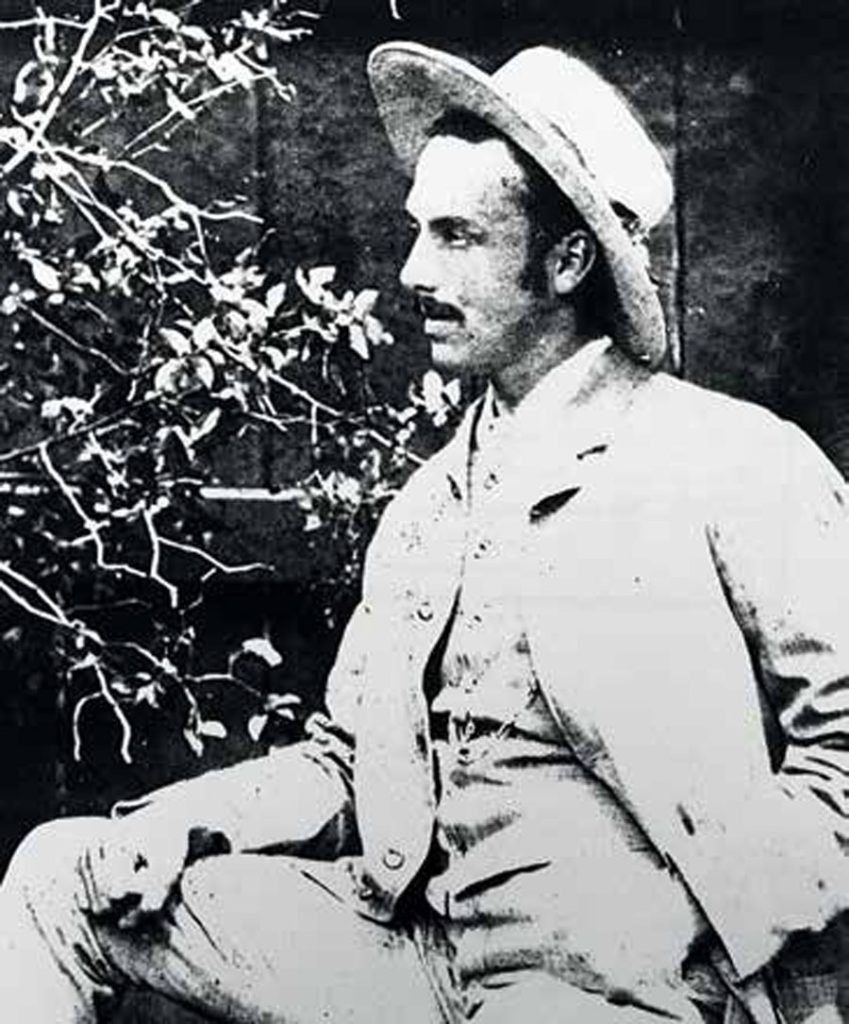
Wave formed part of a fleet of up to twenty little Open Sailing Boats in St. George’s Bay which took no part in the wider Auckland yachting scene centred around the classes catered for by the Anniversary Regatta. The bulk of the other Open Sailing Boats on the Waitematā were in length classes, from 13ft upwards, and were mainly light, professionallybuilt centreboarders with large rigs. They raced for substantial prizemoney in match races fostered by the side betting of the male populace, who tended to bet on anything that moved. However, the St. George’s and Judge’s Bay crowd was an isolated outpost of proud amateurism, and would not race for prizemoney like the rest of the Auckland waterfront.
These St. George’s Bay boats were generally under 15ft in length, probably not centreboard but ‘built down’ and ballasted. Racing was spontaneous and thinly organised but there was a handicap allowance of 15-20 seconds per foot, depending on the course. The main rival to Wave was Sylph, a new 12ft 6in boat built for Dr Wright by Charles Bailey Sr, “one of the prettiest little models on the harbour,” said the Observer. She was named after a prominent racehorse of the time.
At 2.30 pm on Saturday 5th March 1881 a match race was run between Sylph, Wave, handled by T. Carmichael, and the 13-footer Dolly. The course was from St. George’s Bay, around Sandspit buoy off North Head and the Training Schooner’s buoy off Kohimarama and back to the Zulu buoy off St. George’s Bay. Dolly dropped out at the start. Sylph and Wave swapped the lead until the final beat from Kohimarama to the Zulu buoy which Wave rounded first by two lengths.

A week later six yachts started in half a gale, Edina (Cuthbertson), Wave, Pipi, Amy, Dolly and Lily. Wave romped home first by nearly five minutes, cementing her reputation as a heavy weather boat. However, by October 1881, the Sandersons had a new boat, Zulu, the Observer commenting, “The Sanderson brothers have put the Zulu in clipping order for the approaching season. When long Frank has his yachting costume on, he doesn’t look unlike a Zulu himself.”
Zulu’s ancestry is obscure, but she was a small keel yacht of about three tons in the class below the “above four tons and under seven tons” Regatta class, in which the centreboard Jessie Logan had just assumed absolute dominance.
Frank entered Zulu in the November 1881 North Shore Regatta in the ‘Smaller Yacht Race’ against the stiff opposition of Walter Jones’ Maud, and Edmonds’ Sybil but struck trouble. “Poor Frank Sanderson! “, said the Observer, “…the Zulu ripped out her stem head and no sooner was it repaired on Saturday than he carried away his gaff on the wharf, and while luffing to see what was up or down, away went his jib sheets, and long Frank had to send home for a re-fit.”
The Sandersons seem to have kept racing Wave at St. George’s Bay through to March 1882 but then appear to have sold her to Tauranga.
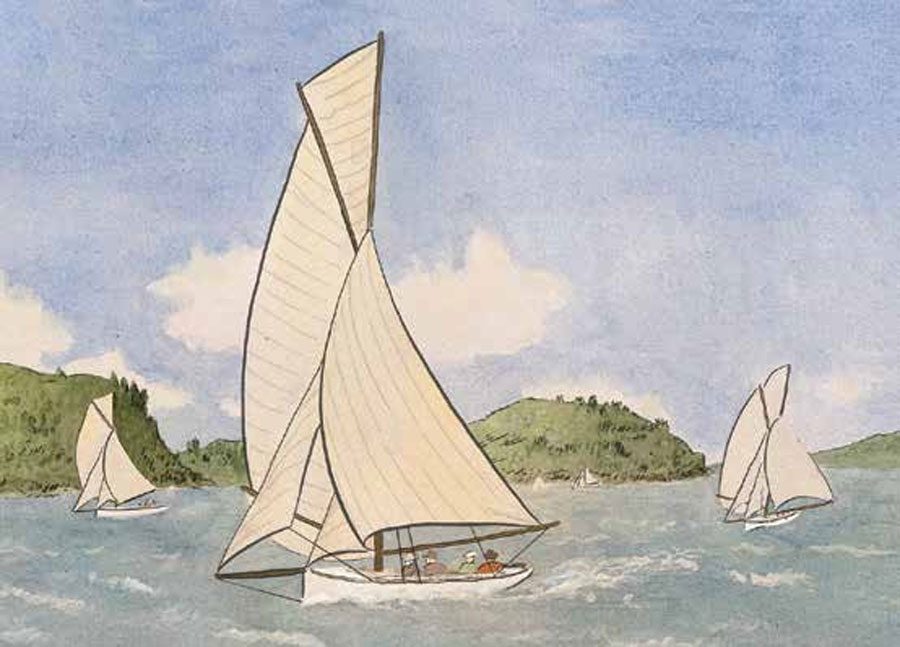
During the winter of 1882, Frank Sanderson had a new keel yacht built of the same class as Zulu. I cannot work out who built her, but her name was Truant, a 3¾-tonner, probably about 24ft to 26ft loa. The first mention of her was in the Observer of November 4: “Truant was out on Saturday with her kites flying. She seemed to travel exceedingly well.”
Truant’s first race was in the North Shore Regatta on November 9 when her major rival was Sybil, now owned by Cramond and Fairs. F. W. Moore was listed as a joint owner of Truant. He was a couple of years older than Frank Sanderson and lived in St. Stephen’s Avenue. Truant started well, but swapped the lead with Sybil several times, Sybil wining by only 12 seconds. The New Zealand Herald said Sybil would have done better, “had she carried a topmast and set a gafftopsail.”
Clearly, the two boats were well-matched. Inevitably, this led to a challenge match race between the two yachts on December 9, 1882. The Observer said the race was for “a handsome yachting cup, bought with a sweepstake, which I consider is a much more sensible plan than competing for a money prize amongst amateurs.” The New Zealand Herald devoted nearly a full column to the race:


SYBIL V. TRUANT
On Saturday last a race took place between the yachts Sybil (Fairs and Cramond) and Truant (Sanderson and Moore). The stakes were invested in a handsome silver cup, which was obtained from the establishment of Mr Lewisson. The course was from the Railway Wharf, round the chequered buoy in Rangitoto Channel, thence to the Daphne’s moorings and the red buoy off the Railway Wharf; twice round, finishing at the starting point. Considerable interest was manifested in this race, as up to the present time the Sybil, the champion yacht of her class, has had an uninterrupted course of victory, winning race after race, whilst the Truant is the only four-ton yacht that has been able to in any way approach her. The Sybil was sailed by M. Fairs, while Frank Sanderson had the Truant in hand.
Both boats were excellently manned, the list of the crews containing some of the best-known names in amateur boating circles… An excellent start was effected at 2.15 p.m. – the Sybil having the windward position, slightly astern of her opponent. The Truant was smartly handled, and was first underweigh, taking the lead down the harbour to the North Head. Both yachts were carrying a press of canvas. The two boats rounded the North Head very quickly, and beat up for the chequered buoy against a stiff breeze and strong tide. The Truant steadily increased her lead and was some distance ahead on gybing at the buoy; setting her spinnaker smartly she ran away before the wind to Judge’s Bay. On again reaching the Railway Wharf, the Truant had still further increased her lead, and continued to gain slightly on the second trip to Rangitoto Channel, where she was some six minutes ahead. Running home for the last time both boats presented a very pretty appearance, having crowded on every available sail, setting spinnakers and watersails in addition to their gafftopsails. The Truant had now too long a lead to be caught, and had nearly passed the winning mark when the Sybil reached the Daphne’s moorings. The race resulted: Truant, 1; Sybil, 2. When in Judge’s Bay the second time round, the Sybil’s spinnaker was taken aback, carrying away the topmast; but, as her opponent was just then finishing the race, this mishap had no effect on the result of the contest. The yacht Minx and a number of other boats accompanied the racing yachts round the course.
The month of December 1882 ended with a challenge from Mort Fairs for another race against Truant, “but Frank Sanderson is not on,” said the Observer.
I pay tribute to Fred Sanderson’s great-granddaughter Robyn Gow of Whangarei whose comprehensive research she has shared with me. BNZ
